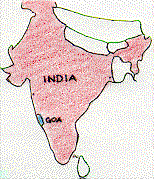
The location of Goa

Ship under construction
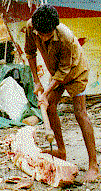
Goan ship builder shaping a frame

Unsuccessful mending of a dugout log with one row of topstrakes. Plugs not fully inserted
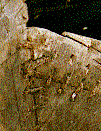
Lashed plank boat with wooden plugs in the sewing holes

Mending a simple dugout
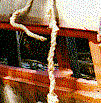
Bottom hull of an outrigger being repaired. The ropes were used to maintain the inserted planks in
place while plugging
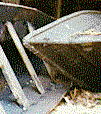
The inside of an outrigger aimed for fishing. Notice the additional construction for outboard motor
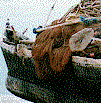
Goan fishing outrigger boat with dugout and several rows of edge to edge sewn strakes. In the boat:
oars and fishing nets

Outrigger dugout with one row of strakes
|
|
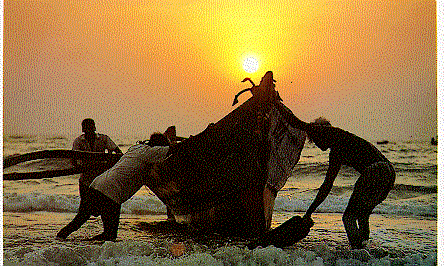
Goa is a small region located on the west coast of India. Nowadays, Goa is by most
people known for its tourist resorts and beach parties. Yet, among the gaiety of colours and the
active common life on the streets and the beaches, one discovers now and then that certain
occurrences still reveal some old traditional traits.
For Goa, seafood has always been the foremost resource of nourishment and much thanks to that,
some fishing and boatbuilding traditions, which origins probably extend over thousands of years,
are still in use. During a short stay there in December 1996, I was sitting on the sandy beach one
afternoon observing a group of fishermen pushing their wooden boat out to the sea. I was wondering
whether what was happening in front of me really was different from what used to happen in
prehistoric times. The boat was an outrigger, built in sewing technique and totally made of wood.
The bottom part of the boat was a dugout log, on which sides two rows of strakes had been sewn up.
The boat had only one outrigger which seemed to be customary here. It was equipped with fishing
nets, wooden oars, a small iron anchor and an outboard motor which was breaking down the romantic
traditional image I had received. The three fishermen were pushing hard to get the boat in the
water. Once floating, they jumped in and started to row further out. Before putting down the
outboard motor, they had to get through the waves breaking down near the shore. After the laborious
row through the waves, the boat went off to the open sea like a smaller motor-boat. It is quite
fascinating, if not alarming, to see how old traditions live in close proximity with modern
facilities.
Here, there and everywhere along the Goan coast, one can see long rows of outriggers being
prepared before going out to sea. Fortunately all the boats were not equipped with outboard motors.
Some of the fishing outriggers belong to the many beach restaurants along the coast while other
boats are owned by self-supporting fishermen. I decided to take a closer look at some of these
boats and ask one of the fishermen where I had to go if I wanted to see boatbuilders building boats
like the ones used here. It wasn't easy to get the answers I was asking for. An aged man, who was
giving his dugout a coat of tar, didn't seem willing to help at first but when I once offered him
Baksheesh (tip), he could suddenly speak English fluently and gladly explained the way to the two
nearest boatbuilding yards. One was located in Chapora and the other in Betim.
The purpose of this text is to present a new photographic material and, on the basis of it and
personal communication with boatbuilders, to point out characteristic traits that might have
ancient traditional background.
Chapora
Chapora is a small village on the northern coast of Goa, well hidden under the tall palm-trees.
A small asphalted road brought me and my hired Vespa to the fishing harbour of Chapora. It laid far
in a creek, well protected from the waves of the open sea. Against the modern quay and further out
in the creek, modern fishing boats were moored and anchored together with simple dugouts and small
wooden boats. Since the quay was not large enough to receive all the bigger boats, the dugouts and
the smaller boats were used as a transport method to get from the shore out to the ships that were
anchored in deeper water. Once again, a mixture of old traditions and modernism. The natural creek
was still not suitable for deep-going ships and the use of dugouts was therefore still essential.
Within a stone's throw from the quay, on the beach, a large amount of fishing boats had been
pulled up to be repaired, stripped or abandoned. Here, there and everywhere on the beach, one could
see dugouts, plankboats of different shape and size and bigger motorised fishing boats. Some of
them had been totally stripped of and laid there exposed to the sun, like skeletons in the desert,
with cracked keels, bottom frames and stems. The boats that were waiting to be repaired or saved
for their still usable wooden parts, had been raised up and sheltered with the help from logs and
woven palm-tree leaves. Dispersed on the beach, one could also see pieces of wood, splinters,
nails, stains of spilled tar, fruit waste and logs of different sizes. A few holy cows walked
freely on the beach looking for edible stuffs thrown by the boat builders.
In the middle of this seemingly sad boatyard, a group of boatbuilders were cheering up the dark
atmosphere by building a brand new fishing boat. The shining light-brown wooden colour of the
future boat was enchanting. I went there and introduced a discussion with three boatbuilders,
sitting on the ground near the ship, carving a large amount of new wooden tree-nails. I tried to
find out about the different materials they used for building a boat, but because of their limited
knowledge in English, the answers were very brief and sometimes incomprehensible. I went on my own
among the boats to look for interesting ethnographic details. Anyway, the scarce information the
boatbuilders succeeded to reveal says that they were using any kind of wood available for the
building of this ship. Mango tree was one of them. The packing material was tar mixed with some
kind of wool. The bottom hull of the ship and some strakes had been recycled from an older
unseaworthy ship. Otherwise, the timbers were sawn and carved by hand and the planks fastened with
large iron screw-bolts.
While walking around on the boatyard, I tried to find some outriggers like the ones mentioned
above. I didn't find any, and hoped that the boatyard at Betim would reveal some. Here in Chapora,
mainly modern motorised fishing boats were built and repaired. But, except the many dugouts laying
around, there was an interesting wooden boat that must have been build according to old traditional
methods. It was an open and a bit worn out plankboat. It was about ten meters long, the planks had
been sewn up by lashing and the sewing hole plugged in with tree-nails. The boat was entirely built
in sewing technique and had upright stems, fore and aft.
Betim
Betim is also located in North Goa, to the North of the capital town Panjim. The boat yard was
well hidden in a large hut covered with woven palm-leaves within the densely urbanised riverside.
Next to the boatbuilding site was a stock of different types of timbers and sawn planks laid up,
aimed for boatbuilding.
Once inside the hut, I was received by two open and friendly boatbuilders instantly asking me if
I wanted take a look at the boats they were building. It was very dark inside but once the eyes had
acclimatised, I could see that the place was full of canoes, dugouts and outriggers. Some were
being repaired and others were under construction. I asked if anyone could speak English and an
apprentice came forward, told me to follow him as he vividly started to point at different boats. I
didn't refuse to a guided show around the yard and hopefully an interesting conversation. The
outriggers here were mostly built in mango-wood because it was the most common tree and teak was of
course more exclusive but not very current. The boats were all repaired and built in the sewing
technique and the packing material was here also made of tar and wool.
by Johan Roque
MA student at the University of Southampton
Links
Edited in 1997 by Graeme Earl,
Department of Archaeology, University of Southampton. Published in 1998 on Nordic Underwater
Archaeology by kind permission. |











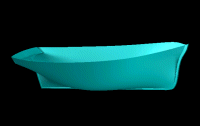 Back to Replicas & Shipbuilding
Back to Replicas & Shipbuilding Back to Nordic Underwater Archaeology
Back to Nordic Underwater Archaeology